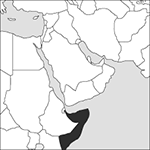
Source: MAPS IN MINUTES™ © RH Publications (1997)
Capital:
Mogadishu
Area:
637,657 sq km (246,201 sq miles)
Population:
10,251,568 (2013 est)
Currency:
1 Somali shilling = 100 cents
Religions:
Sunni Muslim
Ethnic Groups:
Somali 85.0%
Languages:
Somali, Arabic (official); English; Italian
International Organizations:
UN; AU; Arab League; Non-Aligned Movement; WTO
A country on the so-called ‘horn’ in the north-east of Africa.
Physical
Somalia has north and south-east coasts on the Gulf of Aden and the Indian Ocean and borders Ethiopia and Kenya inland. Along its north coast, desert plains rise to the red sandstone hills of a northern plateau. There the only vegetation is thorn-scrub. The south of the country is lower and has one permanent river, the Juba, as a source of irrigation.
Economy
One of Africa’s poorest countries, Somalia has suffered from drought, flooding, famine, civil war, and high foreign debt in recent years. Agriculture, mainly nomadic pastoralism, employs over half the workforce and provides two-fifths of GDP and more than half of export earnings; principal exports are livestock, hides, and fish; bananas used to be the most important export but many plantations have been destroyed in factional fighting. There is little industry. Unexploited mineral resources include lead, gold, zircon, coal, uranium, and kyanite.
History
The kingdom of Punt, mentioned in ancient Egyptian writings, probably occupied the area of Somalia’s northern and eastern coastline. Muslim Arabs and Persians established trading routes in the area between the 7th and 10th centuries ad. Somali nomads had lived in the interior area from at least the 10th century ad and Galla peoples lived in the south and west of the country. After the British occupied Aden (now in Yemen) in 1839 European exploration of the region commenced. The area of the ‘horn’ of Africa was divided between British, French and Italian spheres of influence in the late 19th century. The modern Somali Republic is a result of the unification in 1960 of the former British Somaliland Protectorate and the Italian Trusteeship Territory of Somalia. From then onwards Somalia was involved in border disputes with Kenya and Ethiopia. In 1969 President Shermarke was assassinated in a left-wing coup and the Marxist Somali Revolutionary Socialist Party took power, renaming the country the Somali Democratic Republic under the dictatorship of General Muhammad Siyad Barrah (c.1911–95). There followed 21 years of one-man rule, with a sharply deteriorating economy and an escalating civil war. Fighting broke out in 1988 between government forces and rebel groups, the most important of these being the Somali National Movement (SNM). The country, already hit by drought, now descended into what has been described as the world’s ‘worst man-made disaster’, as refugees fled the insurgents and famine and disease took their toll. Siyad Barrah fled office in January 1991, forming a breakaway grouping, the Somali National Front. The SNM proclaimed a Somaliland Republic in the north, reviving the republic that had briefly succeeded the former British Somaliland protectorate and repudiating a union with ex-Italian Somalia. It has become a stable de facto state, although its independence has not been recognized internationally. By mid-1992 some six million people were facing starvation, as UN troops were deployed against rival warlords throughout the country and relief agencies tried, in the face of the warlords’ opposition, to alleviate the suffering. After UN peacekeeping forces, led by the USA, had failed to maintain a ceasefire, troops were withdrawn by March 1995. General Muhammad Aidid (1936–96) declared himself President in 1995, but this was not accepted by the international community. In 1996 he was killed in battle and was succeeded by his son, Hussein Aidid. Factional fighting continued despite several agreements and attempts to create a viable government. A transitional assembly was established in 2004, a President elected, and a government—the Transitional Federal Government (TFG)—appointed (2005). However, these bodies were riven by faction and their authority was marginal. In 2006 violence flared up again when the Islamic Courts Union (ICU) routed rival warlords and seized Mogadishu, declaring its intention of creating a strict Islamic state. Ethiopia sent troops to assist the TFG and the ICU was expelled from Mogadishu in 2007; however, one faction, al-Shabaab, which was linked to al-Qaeda, continued to wage a guerrilla campaign and captured towns in central and south Somalia. In 2009 the TFG was expanded to include a moderate Islamist faction and formed an alliance with other groups, including the ICU, against al-Shabaab. When the TFG’s mandate expired in 2012, a provisional constitution was adopted and a parliament established with appointed members. This body elected Hassan Sheikh Mohamud as President of the Federal Government of Somalia. With international help the areas under government control gradually expanded as al-Shabaab was driven back. However, Islamist attacks still regularly occur in the cities and countryside of Somalia. In 2017 parliament elected a new President, Mohamed Abdullahi ‘Farmajo’ Mohamed, who defeated the incumbent Sheikh Mohamud.